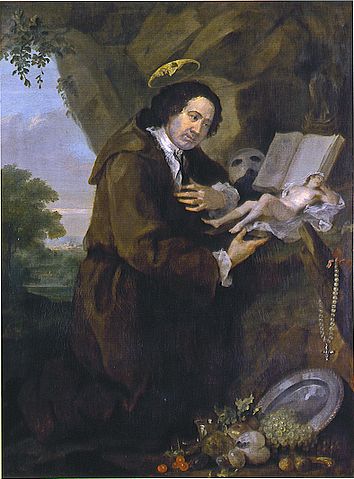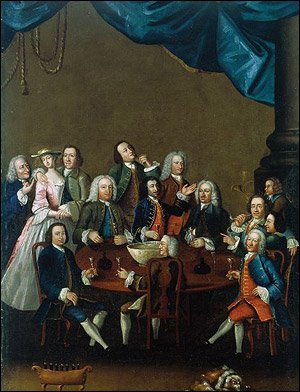The Hellfire Clubs – decadence, with a whiff of brimstone

No organisation quite captures the air of genteel decay that pervaded English society in the Georgian era quite like the Hellfire Club. The 18th and early 19th century was a hard time for England. A succession of wastrel princes became weak kings. The former colonies of America revolted. They were dragged into wars over matters as trivial as the severed ear of a smuggler. [1] They found themselves at a crossroads. Educated enough to recognise their own squalor, but not educated enough to see their way clear of it. The political situation was “stable”, which translated to stagnant. The lack of any chance of effecting change politically with the parties so undifferentiated led to civil unrest. Mass media was now firmly entrenched (with newspapers becoming more and more common as the century went on), but the ruling classes had not yet realised that this meant that all their doings were now to be laid firmly out on display for all to see. These included the savage exploits of well-born terrors like the Mohocks who disfigured male victims, sexually assaulted female ones and wound up being charged petty sums by biased magistrates. It was in this atmosphere that the Hellfire Clubs were born.
The first Hellfire Club was founded in 1719 by the Duke of Wharton, a powerful Whig politician and noted “rake”. This club concerned itself mostly with deliberate blasphemy, the members dressing up as biblical figures and then acting out mocking plays which (according to the newspapers) usually degenerated into orgies. Blasphemy was linked closely to sedition in the English mind – the King, after all, being head of the church; and the strong role that religion had played in the civil war of the previous century was not forgotten. Wharton was at this time on the way up as a politician, and the Hellfire Club was one stick his opponents used to try to beat him back down. A royal decree was issued to ban them in 1721 and Wharton was forced to stand up in the House of Lords and deny his patronage of blasphemy. Wharton would go on to briefly lead the opposition before gradually slipping further into both debt and into support for the Jacobite cause, which would eventually see him charged with treason for fighting in the Jacobite forces that besieged Gibraltar. He died in Catalonia in 1731, from the effects of advanced alcoholism.

Fifteen years later, Sir Francis Dashwood founded the most famous of the Hellfire Clubs, though it never officially bore that name. Instead they were known by a variety of names, the first of which was the Order of the Knights of St Francis (based on Dashwood’s name). They took as their motto “Do What Thou Wilt”, a phrase from the writings of the monk Rabelais that would later be adopted by Aleister Crowley. Their interpretation of the phrase was far different from his, of course – fully embracing the hedonistic implications of the phrase. Their members included several of the most notorious hellraisers of the day, such as Dashwood himself (who claimed to have seduced the Empress of Russia by pretending to be the King of Sweden), John Montagu (the Earl of Sandwich, for whom the foodstuff is named), John Wilkes, Thomas Potter and allegedly even Benjamin Franklin, though he was never a formal member. The painter William Hogarth (who specialised in scenes of social depravity) is also said to have been a member.
This Hellfire Club was sometimes known as the Monks of Medmenham Abbey, after an abandoned monastery where Dashwood would lead them in “Satanic” rites. This was a matter of mocking social conventions rather than any genuine devotion, however, and the “sacrifice” they laid on the altar was usually a prostitute who they would publicly fornicate with while the berobed attendees hooted and hollered, drinking wine from pilfered chalices. Later they moved to the caves beneath Dashwood’s family home of West Wycombe. The layout of these caves is often claimed to followed occult principles in some way. Dashwood had them enlarged ostensibly as a charity makework project for local men, and engraved them with occult scenes. During one of the ceremonies in the caves, John Wilkes is said to have smuggled in a baboon, dressed in a robe and mounted with horns. He had the beast inside a box that he could release with a tug of a string, and when he did so it leapt upon Montagu. The Earl mistook it for the devil himself come to take him away, and cried out: “Spare me gracious Devil: spare a wretch who never was sincerely your servant. I sinned only from vanity of being in the fashion; thou knowest I never have been half so wicked as I pretended.” Whether the story is true or not (historians generally believe not, though it is a good story), it is certain that the two men went from being good friends to bitter enemies around this period. [2]
Some historians believe that Dashwood’s outward revelries concealed political machinations. Montagu, Dashwood and Wilkes were very active in politics, holding respectively the ranks of First Lord of the Admiralty (the equivalent of the modern Prime minister), Chancellor of the Exchequer and Lord Mayor of London. Though Wilkes fell out with the other two, they were all heavily involved in the lead up to the American Revolutionary War, in which their friend Ben Franklin would of course play a major role. In truth, however, the fact is that politics were corrupt at the time, and corruption is rarely a one way street. The London club scene had more of an affect on the governance of the country than the will of the people ever did, and Dashwood’s Hellfire Club was merely one of extreme edges of that scene. [3]

Ireland had several Hellfire Clubs of its own, though they were less formal affairs than those in England. The Dublin Hellfire Club was founded in 1735, before Dashwood’s club, and made its official headquarters in Mount Pelier, a hunting lodge in County Dublin. They would also meet in several bars around Dublin, their most common haunt being the Eagle Tavern in Templebar. [4] Meetings would begin with a toast to the Devil, drunk with scaltheen. Scaltheen was a mixture of whisky, butter, sugar and pepper – a predecessor to the modern day Irish Cream. It required considerable skill to make, and still tended to retain a burnt edge to the flavour. Chamber’s Book of Days recounts how members of the Dublin “HF Club” would drink “burning scaltheen, standing in impious bravado before blazing fires, till, the marrow melting in their wicked bones, they fell down dead upon the floor”.
The club was founded by Richard Parsons, the first Earl of Rosse, and began as a light-hearted affair poking fun at the social conventions of the day. Rosse was known as a prankster – even on his deathbed, when he received a letter from a vicar condemning his wickedness, he noted the lack of a name in the note itself (which began “My Lord”) and sent it on in a fresh envelope to the Earl of Kildare. The Earl, who was a pious man, complained to the Archbishop of Dublin, and the unfortunate vicar received a fair roasting before Rosse’s prank was uncovered – and by that point, he was dead and past caring. Another important member in the club’s early years was James Worsdale, an Irish artist. Worsdale was greatly in demand during his lifetime as a portrait painter, and he painted both the Dublin and Limerick Hellfire Clubs. The latter is one of the few records we have of that club, which met in Askeaton, and unusually included a woman (Margaret Blennerhasset, known as “Celinda”) as a full member.

In later years, the Dublin Hellfire Club became less of a joking matter. The leadership of the club came to a man called Richard Chappell Whaley, known as “Burn-Chapel” due to his habit of burning down Catholic churches. Fire definitely seems to have been his obsession, as he would reportedly douse cats in scaltheen and set them alight in club meetings as an amusement. It was under his leadership that Mount Pelier was burnt out to an empty shell. The locals had always said that the lodge was cursed, built as it was with stones taken from an ancient cairn. The tale has it that Whaley had paid an unfrocked clergyman to perform a Black Mass in the lodge, and as one might expect following the ceremony things devolved into a drunken free for all. After all had collapsed in a drunken stupor, a footman offended Whaley in some manner (either by tripping over him as he slept, or by spilling drink on him, or by Whaley tripping over him). The enraged Whaley doused the servant in brandy and set him alight, and the fire soon took hold within the lodge. Whaley escaped by jumping out a window, but the majority of the club’s members were not so lucky. The gutted remains of the lodge sit on Montpelier Hill to this day.

The burning of the lodge marked the end of the Dublin Hellfire Club as an active institution, though Whaley’s son Thomas “Jerusalem” Whaley [5] would try to revive the club in the 1780s. The Hellfire Club as an actual club was finished – but the Hellfire Club as a legend seized hold in the popular imagination. The most common image of it was a conglomeration of Dashwood’s political elite and Whaley’s overt anti-clerical satanism. In this guise the Hellfire Club has appeared all across literature, from Jerome K Jerome’s Three Men in a Boat to Marvel’s X-Men comics and movies. The Avengers episode A Touch of Brimstone is one of the most famous depictions of the club on screen, featuring them as hedonistic nihilists intent on kicking off global wars for their own profit and amusement. There is even a club in London nowadays that takes the name of the Hellfire Club for its own, though as a “Swinger’s Club” it is perhaps closer to the smutty reality of the original than the preferred literary legend. The Hellfire Club came, in the mind of the public, to embody the most paranoid fantasies of the middle classes about what their “betters” got up to behind closed doors. The idea that the only thing preventing you from “doing what thou wilt” is the constraints of your position is a powerful one, and while not all people succumb to that temptation, history shows that it doesn’t take a devil born in Hellfire to drive people to excess.
[1] This, of course, oversimplifies matters enormously. The “War of Jenkins’ Ear” was actually about the English retaining the highly profitable contract to sell slaves to South America. However, on the scale of justifications for war, “retaining a slave trading contract” ranks even below “demanding our freedom to sell drugs to the Chinese”, so Jenkins became the poster boy for the war.
[2] The most famous exchange between them was when Montagu said that he did not know if Wilkes would die “on the gallows or of the pox”, and Wilkes replied “That depends, my lord, on whether I embrace your lordship’s principles or your mistress.”
[3] And far from the worst, either. One of the most notorious clubs of the time was the Beggar’s Benison, a club whose induction ceremony involved group masturbation and which allegedly counted the Prince of Wales among its members.
[4] The Eagle Tavern, now demolished, has a much more significant role in history as the founding place of the Dublin branch of the Society of United Irishmen. This initially peaceful group quickly fell under the sway of radical elements, leading to the Irish Rebellion of 1798.
[5] So named because he once went to visit Jerusalem on a bet. His memoirs of the journey are a fascinating travelogue, though due to their scandalous remarks about Dublin nobility they were suppressed for over a century and only published in 1906.
